Opsumit shows real-world safety, efficacy for CTD-PAH patients
Treatment mostly given as combination therapy, US drug registry studies find

Most people with pulmonary arterial hypertension (PAH) due to connective tissue disease (CTD) who are using Opsumit (macitenan) do so as part of a combination therapy, according to real-world evidence from two U.S. drug registry studies.
Its safety and effectiveness, in terms of clinical outcomes, for these patients were comparable to people with idiopathic (of unknown cause) or hereditary PAH, more common disease types.
“We show that macitentan [Opsumit] is used in newly diagnosed and prevalent patients with CTD-PAH … as part of a combination therapy regimen in the majority of patients,” the scientists wrote.
The study, “Macitentan in Pulmonary Arterial Hypertension Associated with Connective Tissue Disease (CTD-PAH): Real-World Evidence from the Combined OPUS/OrPHeUS Dataset,” was published in the journal Cardiology and Therapy.
Opsumit works to widen blood vessels in PAH patients
PAH is characterized by the narrowing of the pulmonary arteries, the blood vessels that supply the lungs, which restricts blood flow and causes high blood pressure. This forces the heart to work harder to pump blood through the body, and can lead to right heart failure.
Opsumit is an oral, once-daily therapy that works to widen the blood vessels of people with PAH, slowing disease progression and lowering patients’ risk of being hospitalized.
“However, patient characteristics, treatment patterns, safety profile, and outcomes of patients with CTD-PAH … newly initiating [Opsumit] are not well understood,” the scientists wrote. CTD refers to disorders affecting the connective tissue — which supports and holds organs together — such as systemic lupus erythematosus or scleroderma.
Researchers in the U.S. analyzed data from two real-world studies of patients newly treated with Opsumit: OPUS (NCT02126943) — the OPsumit USers Registry — and OrPHeUS (NCT03197688), the Opsumit Historical Users study that was initiated to supplement OPUS registry data. Collected findings covered the years 2013 to 2022.
“Data from both studies provide a unique insight into contemporary real-world clinical practice for the management of a broad range of patients with PAH, including those with CTD-PAH, and report real-life clinical outcomes of these patients, complementing the findings of [randomized, controlled trials] and other registries,” the researchers added.
The combined study population was 5,654 patients, with a majority (81.9%) diagnosed with PAH and having follow-up data. Among this group, 4,459 patients had PAH as the only reason for using Opsumit — most had idiopathic or hereditary PAH (2,498 people, 56%), followed by CTD-PAH (1,192 people, 26.7%). The CTD-PAH group included 708 people with scleroderma, 159 with systemic lupus erythematosus, and 124 with PAH associated with mixed connective tissue disease.
Across all groups, most patients were white (52.6% to 79.7%) and their median age ranged from 49 to 64 years.
Compared to patients with idiopathic and hereditary PAH, those with CTD-PAH at Opsumit initiation were more frequently women (86.2% vs. 73.1%); were more commonly in World Health Organization functional class III/IV (69.3% vs. 61.2%), meaning they had more severe disease symptoms; and they were less likely to be obese (20.6% vs. 34.1%).
Most CTD-PAH patients using Opsumit as part of a combination therapy
Before starting on Opsumit, 61.4% of idiopathic or hereditary PAH patients and 68.4% of those with CTD-PAH had received at least one previous PAH-specific therapy. The median duration of Opsumit treatment was 14 months for participants with idiopathic/hereditary PAH and 15.8 months for those with CTD-PAH.
A higher proportion of CTD-PAH patients received Opsumit as part of combination therapy (65.2% vs. 58.1%), mainly given with a phosphodiesterase 5 inhibitor. This group of therapies includes Adcirca (tadalafil) and Revatio (sildenafil). In addition, at one and two years of treatment, results showed that patients with CTD-PAH were more likely to escalate from monotherapy to combination therapy, and from double to triple therapy, than were people with idiopathic or hereditary PAH.
Compared with the larger PAH group, “a higher proportion of patients with CTD-PAH initiated [Opsumit] as part of combination therapy and were more likely to escalate therapy up to 2 years after [Opsumit] initiation,” the scientists wrote.
Still, “contrary to guideline recommendations, a considerable proportion remained on monotherapy therapy at follow-up,” they added.
Adverse events were recorded only in the OPUS study, and most patients experienced at least one such event. The most common side effects were shortness of breath, headache, and edema (swelling).
One year into treatment, 60.3% of the patients with idiopathic/hereditary PAH and 59.3% of those with CTD-PAH had no need for hospitalization due to any cause. Moreover, both groups showed a similar survival rate at one year (90.5 vs. 90.6%) and at three years (75.5 vs. 74.3%) of treatment.
“The outcomes of patients with CTD-PAH in our study indicate progress has been made for early diagnosis and improved treatment options, however, outcomes could be further enhanced with increased use of initial combination therapy,” the researchers wrote.








